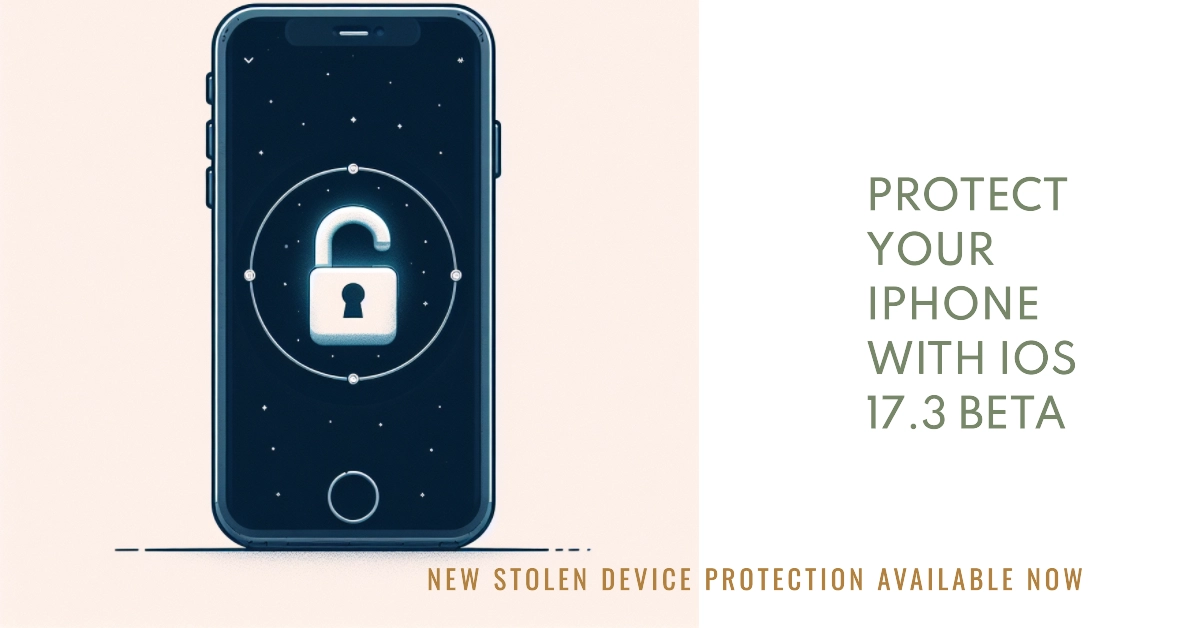Apple’s latest iOS 17.3 beta update introduces a crucial security feature for iPhone users: Stolen Device Protection. This innovative tool adds an extra layer of protection to your iPhone, making it significantly harder for anyone with your passcode to access sensitive information or disable important features.
In this article, we’ll explore how Stolen Device Protection works and guide you through the steps to enable it on your iPhone.
What is Stolen Device Protection?
This feature provides an additional layer of security in case your iPhone is stolen and the thief manages to obtain your passcode.
With Stolen Device Protection enabled, critical actions like accessing passwords stored in iCloud Keychain, applying for a new Apple Card, turning off Lost Mode, or erasing your iPhone will require biometric authentication (Face ID or Touch ID) instead of just your passcode.
This makes it significantly harder for unauthorized individuals to gain access to your personal data and accounts, even if they know your passcode.
How Stolen Device Protection Works
With Stolen Device Protection enabled, your iPhone will require biometric authentication (Face ID or Touch ID) for a wide range of actions, even if you know the passcode.
This means that even if a thief manages to get their hands on your iPhone and your passcode, they will still be unable to access your sensitive information, change your Apple ID password, or disable Find My iPhone.
What Actions Require Biometric Authentication?
Now that you understand the basic concept of Stolen Device Protection, let’s take a closer look at specific actions that require your biometric authentication:
- Accessing passwords stored in iCloud Keychain: This includes website logins, credit card information, and other sensitive data.
- Applying for a new Apple Card: Stolen Device Protection prevents unauthorized individuals from using your iPhone to apply for a new Apple Card under your name.
- Turning off Lost Mode: This safeguard ensures that a thief cannot disable Find My iPhone and erase its location data.
- Erasing all content and settings: This prevents a complete wipeout of your data without your biometric confirmation, giving you a chance to recover your iPhone if it’s located.
- Using payment methods saved in Safari: This includes credit card information and other payment methods stored in Safari for automatic checkout.
- Many other sensitive actions: Stolen Device Protection also covers a range of additional functions, such as changing your Apple ID password, disabling Find My, and creating a new passcode. For example, changing your Apple ID password, enabling or changing your recovery key, or disabling Touch ID or Face ID will require two separate biometric scans within an hour of each other.
How to Enable Stolen Device Protection
To enable Stolen Device Protection on your iPhone running the iOS 17.3 beta, follow these simple steps:
- Update your iPhone to iOS 17.3 beta: Make sure you have the latest version of iOS installed on your iPhone.
- Open the Settings app.
- Tap on your Apple ID banner.
- Select “Password & Security.”
- Scroll down and find “Stolen Device Protection.”
- Turn on the toggle next to “Stolen Device Protection.”
Once you’ve enabled Stolen Device Protection, you’ll be prompted to re-authenticate with Face ID or Touch ID. This is to ensure that you’re the authorized user making the change.
Additional Precautions for Enhanced Security
While Stolen Device Protection is a powerful security feature, it’s always a good idea to take additional precautions:
- Use a strong and unique passcode: Don’t rely on simple passcodes like “1234” or your birthday. Choose a complex combination of numbers, letters, and symbols that is difficult to guess.
- Enable Find My iPhone: This feature allows you to track the location of your iPhone if it’s lost or stolen, even if it’s offline.
- Keep your software up to date: Apple regularly releases software updates that address security vulnerabilities. Make sure to install these updates as soon as they become available.
- Be cautious when sharing your password: Avoid sharing your iPhone passcode with anyone, even trusted friends or family members.
More Important Information
Here are some additional things to keep in mind about Stolen Device Protection:
- Stolen Device Protection is currently only available in the iOS 17.3 beta. It is expected to be released to the public with the official iOS 17.3 update.
- If you forget your passcode and haven’t enabled two-factor authentication, you will no longer be able to access your iPhone if you enable Stolen Device Protection.
- It’s still important to use a strong passcode for your iPhone, even with Stolen Device Protection enabled.
- If you have concerns about the security of your iPhone, you can always contact Apple Support for more information.
Overall Thoughts
By enabling Stolen Device Protection, you can significantly improve the security of your iPhone and protect your data from unauthorized access. This new feature is a welcome addition to the iOS security suite and is sure to be appreciated by iPhone users around the world.
